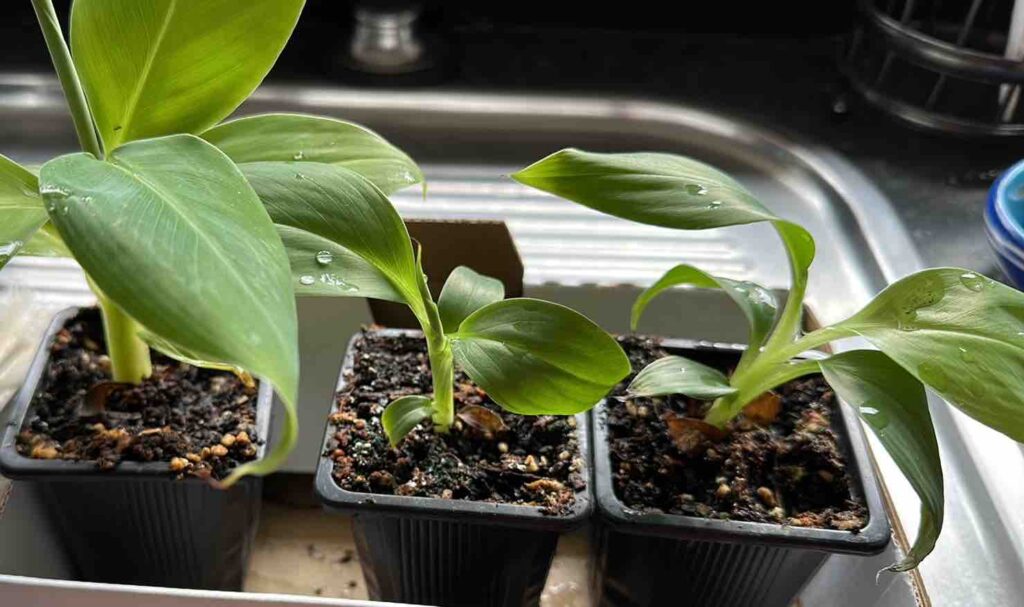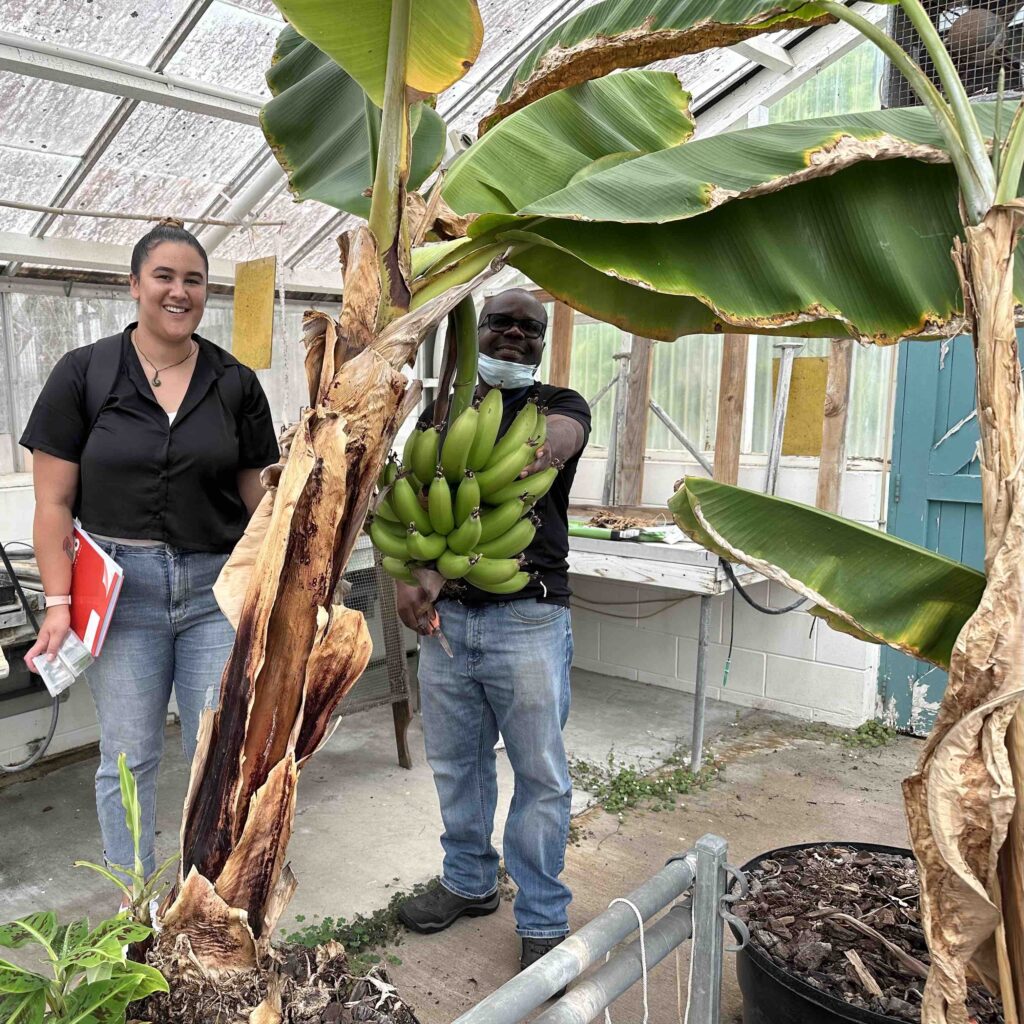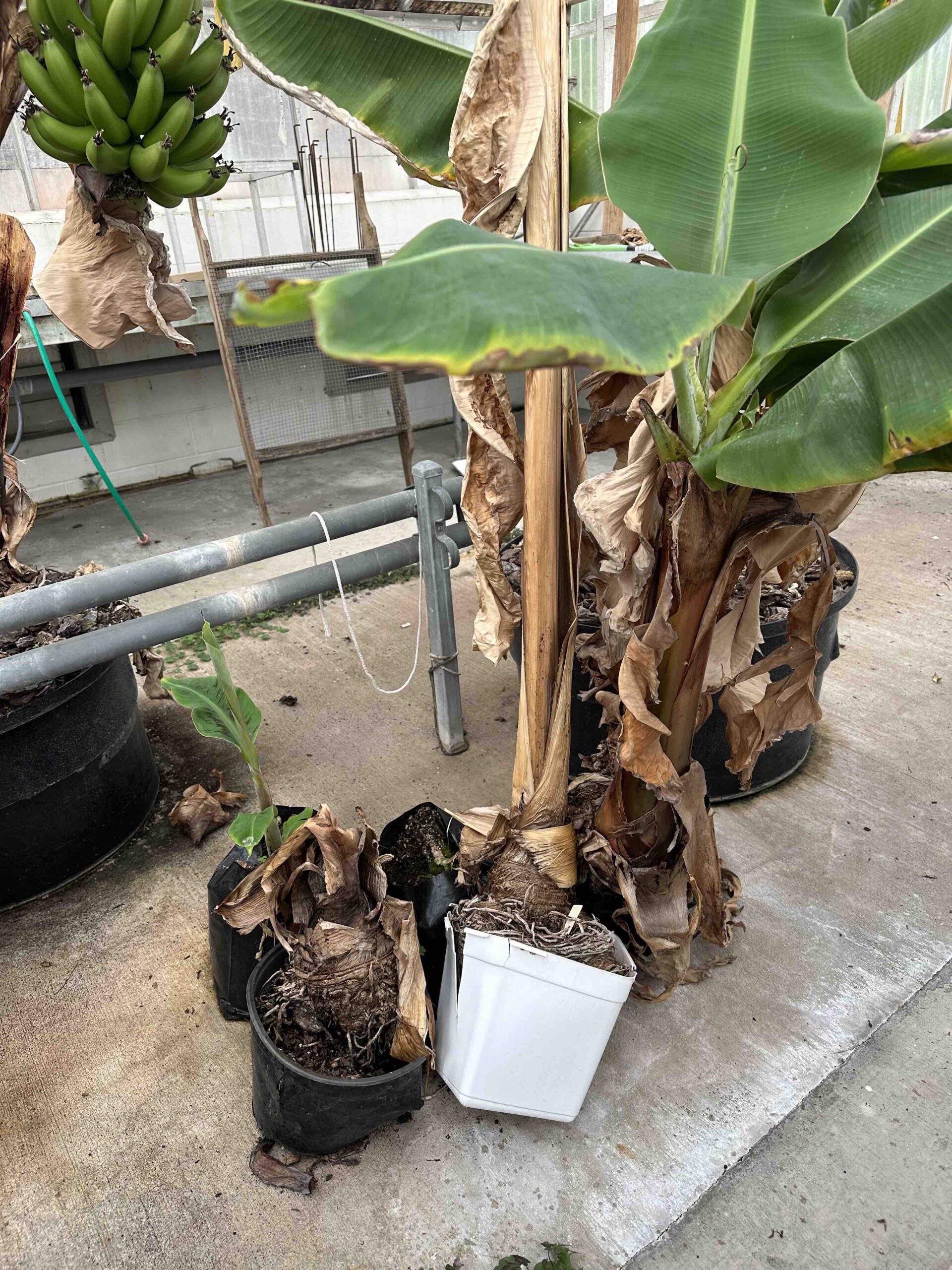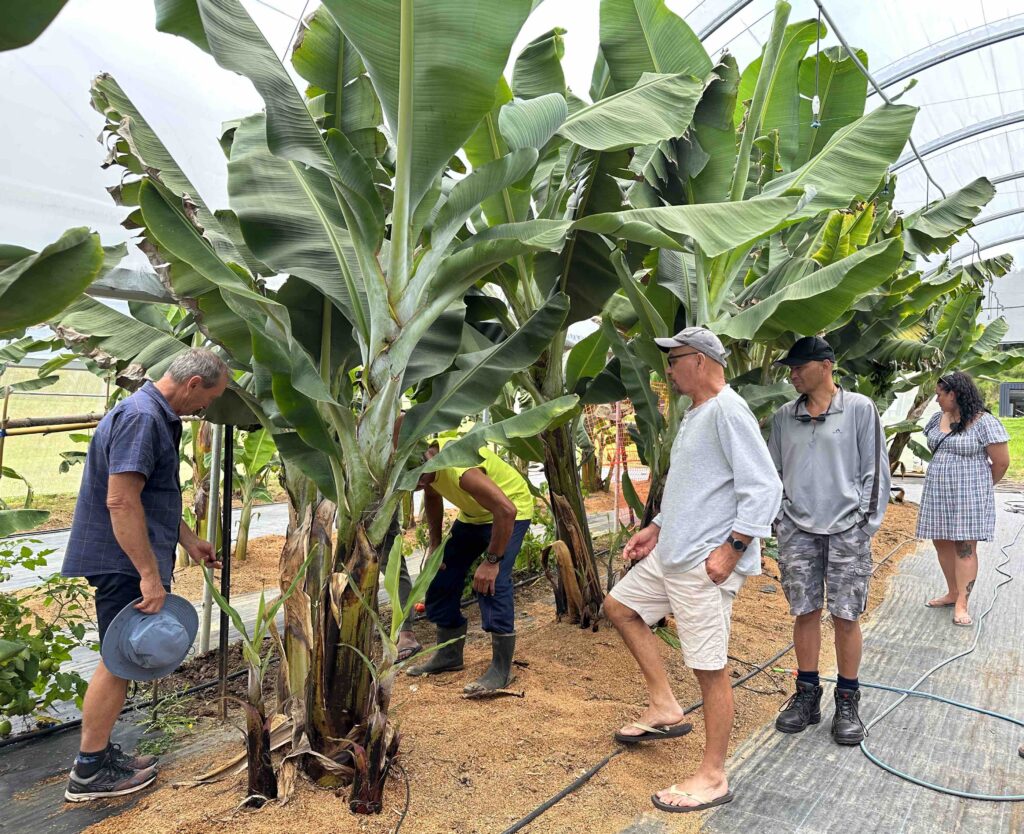Here is what I do with my bananas over winter. I buy a wrap through online companies that sell from China a plant wrap to insulate the stem over winter. Unwrap when spring arrives and the danger of frost is passed.

Here is what I do with my bananas over winter. I buy a wrap through online companies that sell from China a plant wrap to insulate the stem over winter. Unwrap when spring arrives and the danger of frost is passed.

Tissue culturing banana is achieved by stripping back the outside to find the meristem and the stem cells then regenerating these in growth media under sterile conditions.
It takes about 3 weeks to initiate growth, then another 5-6 weeks to multiply and then a further 3-4 weeks until there is a plant with roots ready to go in to soil.




Its both easier and harder in some ways. What we know is that bananas tolerate a wide range of conditions. But they do not like the cold or the wind.
That said, a number of bananas are being grown across the warmer and more sheltered parts of NZ from North Taranaki to the East Coast and Gisborne, from Hawke’s Bay to Martinborough, from Palmerston North and Feilding to Whanganui. Northland are already into a commercial quantity and others will follow soon.
How to grow and care for your banana
Dwarf Cavendish
Below are pictures of Dwarf Cavendish growing under cover in 2 different tunnel houses in Northland near Whangarei.




Starin McKeen, Clare Wall, Hannah Eriksen, Amy Lovell, Jane Mullaney, Wayne Young, Karl Fraser, Nicole Roy, Warren McNabb.
Current Developments in Nutrition (2020)
Abstract
Objectives
The rapid diversification of foods introduced during complementary feeding coincides with profound changes in the infant gut microbiome, with potential effects on immediate and long-term health outcomes. The objective of this study is to elucidate dietary modulators of the infant gut microbiome by characterising dietary intake by food groups, nutrient composition, and nutrient source, followed by multivariate integration with faecal microbiome data.
Methods
Three-day food records were collected from a cohort of 40 infants recruited from the Auckland metropolitan area in New Zealand, who participated in a 6-month dietary intervention clinical pilot study. Thirty infants were provided kumara as an additional food to include in the daily diet, while 10 infants were provided commercially available probiotic drops (Bifidobacterium lactis) as a daily supplement. Faecal samples were collected on the final day of the 3-day food record at approximately 6, 9, and 12 months of age, and analysed using shotgun metagenomics and global metabolite profiling. Multivariate approaches have been used to integrate diet, microbiome, and metabolomic data.
Results
Preliminary results indicated that at 9 months of age some B-vitamins and minerals from meat products were strongly correlated (coefficient of ≥.6 using canonical correlations) with increased microbiome amino acid metabolism and biosynthesis, whereas a strong inverse correlation (≤–.6) was observed between breastmilk and dietary fibre consumption. At 12 months of age, the significance of associations throughout the network were diminished, and food intake data suggested that legumes, eggs, dairy products, breastmilk, and infant formula were the predominant modulators of metabolic pathways.
Conclusions
While specific nutrients and food groups correlate independently with significant alterations in the microbiome, merging these metrics to encompass nutrient source provides a more complete understanding of dietary modulators from the perspective of the gut microbiome. The immature gut microbiome of younger infants may be more profoundly influenced by dietary factors than increasingly mature microbiomes.Funding Sources
This study was funded by the New Zealand Ministry of Business, Innovation, & Employment High-Value Nutrition National Science Challenge.
Ankita Jena, Carlos A. Montoya, Jane A. Mullaney Ryan N. Dilger, Wayne Young, Warren C. McNabb and Nicole C. Roy
Frontiers in Integrative Neuroscience (2020)
Abstract
Emerging evidence suggests that alterations in the development of the gastrointestinal (GI) tract during the early postnatal period can influence brain development and vice-versa. It is increasingly recognized that communication between the GI tract and brain is mainly driven by neural, endocrine, immune, and metabolic mediators, collectively called the gut-brain axis (GBA). Changes in the GBA mediators occur in response to the developmental changes in the body during this period. This review provides an overview of major developmental events in the GI tract and brain in the early postnatal period and their parallel developmental trajectories under physiological conditions. Current knowledge of GBA mediators in context to brain function and behavioral outcomes and their synthesis and metabolism (site, timing, etc.) is discussed. This review also presents hypotheses on the role of the GBA mediators in response to the parallel development of the GI tract and brain in infants.
Ahlborn, N., Young, W., Mullaney, J. A., Samuelsson L, M (2020).
Nutrients
While human milk is the optimal food for infants, formulas that contain ruminant milk can have an important role where breastfeeding is not possible. In this regard, cow milk is most commonly used. However, recent years have brought interest in other ruminant milk. While many similarities exist between ruminant milk, there are likely enough compositional differences to promote different effects in the infant. This may include effects on different bacteria in the large bowel, leading to different metabolites in the gut. In this study sheep and cow milk were digested using an in vitro infant digestive model, followed by fecal fermentation using cultures inoculated with fecal material from two infants of one month and five months of age. The effects of the cow and sheep milk on the fecal microbiota, short-chain fatty acids (SCFA), and other metabolites were investigated. Significant differences in microbial, SCFA, and metabolite composition were observed between fermentation of sheep and cow milk using fecal inoculum from a one-month-old infant, but comparatively minimal differences using fecal inoculum from a five-month-old infant. These results show that sheep milk and cow milk can have differential effects on the gut microbiota, while demonstrating the individuality of the gut microbiome. View Full-Text
Barnett, A. M., Mullaney, J. A.,** Hendriks, C., et al. (2021) ** equal first author
American Journal of Physiology – Cell Physiology 2021
The development of alternative in vitro culture methods has increased in the last decade as three-dimensional organoids of various tissues, including those of the small and large intestines. Due to their multicellular composition, organoids offer advantages over traditionally used immortalized or primary cell lines. However, organoids must be accurate models of their tissues of origin. This study compared gene expression profiles with respect to markers of specific cell types (stem cells, enterocytes, goblet, and enteroendocrine cells) and barrier maturation (tight junctions) of colonoid and enteroid cultures with their tissues of origin and colonoids with enteroids. Colonoids derived from three healthy pigs formed multilobed structures with a monolayer of cells similar to the crypt structures in colonic tissue. Colonoid and enteroid gene expression signatures were more similar to those found for the tissues of their origin than to each other. However, relative to their derived tissues, organoids had increased gene expression levels of stem cell markers Sox9 and Lgr5 encoding sex-determining region Y-box 9 and leucine-rich repeat-containing G protein-coupled rector 5, respectively. In contrast, expression levels of Occl and Zo1 encoding occludin and zonula occludens 1, respectively, were decreased. Expression levels of the cell lineage markers Atoh1, Cga, and Muc2 encoding atonal homolog 1, chromogranin A, and mucin 2, respectively, were decreased in colonoids, whereas Sglt1 and Apn encoding sodium-glucose transporter 1 and aminopeptidase A, respectively, were decreased in enteroids. These results indicate colonoid and enteroid cultures were predominantly comprised of undifferentiated cell types with decreased barrier maturation relative to their tissues of origin.
Juliana A. S. Leite1, Carlos A. Montoya1,2, Simon M. Loveday1,2, Evelyne Maes3, Jane A. Mullaney1,2,4, Warren C. McNabb1,4* and Nicole C. Roy1,4,5,6
Frontiers in Nutrition 2021
Proteases present in milk are heat-sensitive, and their activities increase or decrease depending on the intensity of the thermal treatment applied. The thermal effects on the protease activity are well-known for bovine milk but poorly understood for ovine and caprine milk. This study aimed to determine the non-specific and specific protease activities in casein and whey fractions isolated from raw bovine, ovine, and caprine milk collected in early lactation, and to determine the effects of low-temperature, long-time (63°C for 30 min) and high-temperature, short-time (85°C for 5 min) treatments on protease activities within each milk fraction. The non-specific protease activities in raw and heat-treated milk samples were determined using the substrate azocasein. Plasmin (the main protease in milk) and plasminogen-derived activities were determined using the chromogenic substrate S-2251 (D-Val-Leu-Lys-pNA dihydrochloride). Peptides were characterized using high-resolution liquid chromatography coupled with tandem mass spectrometry. The activity of all native proteases, shown as non-specific proteases, was similar between raw bovine and caprine milk samples, but lower (P < 0.05) than raw ovine milk in the whey fraction. There was no difference (P > 0.05) between the non-specific protease activity of the casein fraction of raw bovine and caprine milk samples; both had higher activity than ovine milk. After 63°C/30 min, the non-specific protease activity decreased (44%; P > 0.05) for the bovine casein fraction only. In contrast, the protease activity of the milk heated at 85°C/5 min changed depending on the species and fraction. For instance, the activity decreased by 49% for ovine whey fraction, but it increased by 68% for ovine casein fraction. Plasmin and plasminogen were in general inactivated (P > 0.05) when all milk fractions were heated at 85°C/5 min. Most of the peptides present in heat-treated milk were derived from β-casein and αS1-casein, and they matched the hydrolysis profile of cathepsin D and plasmin. Identified peptides in ruminant milk samples had purported immunomodulatory and inhibitory functions. These findings indicate that the non-specific protease activity in whey and casein fractions differed between ruminant milk species, and specific thermal treatments could be used to retain better protease activity for all ruminant milk species.
The microbial community making up the gut microbiota can profoundly influence intestinal homeostasis and immune system development, and is believed to influence the development of complex diseases including type 1 diabetes (T1D). T1D susceptible nonobese diabetic (NOD) mice have been shown to harbor a distinct microbiota to disease-protected mice. We hypothesized that the T1D susceptible genetic background of NOD mice would be resistant to the introduction of a C57BL/6-derived microbiota. NOD and C57BL/6 mice were cohoused either continually from birth, from birth until weaning or from weaning onwards, allowing transfer of microbiota between the mice. Cohousing NOD with C57BL/6 mice from before birth, resulted in moderate changes to the gut microbiota, whereas initiating cohousing at weaning only led to minimal changes. Terminating cohousing at weaning reduced the changes in the microbiota composition. However, diabetes onset was not significantly delayed and there was no reduction in intestinal inflammation or the proportion of regulatory T cells in the cohoused NOD mice. However, insulin but not islet-specific glucose-6-phosphatase catalytic subunit-related protein-specific CD8+ T cells were reduced by cohousing suggesting an epitope-specific modulation of the autoreactive response by the gut microbiota. These results suggest that the T1D susceptible genetic background of the NOD mouse was resistant to the introduction of a C57BL/6-derived microbiota.